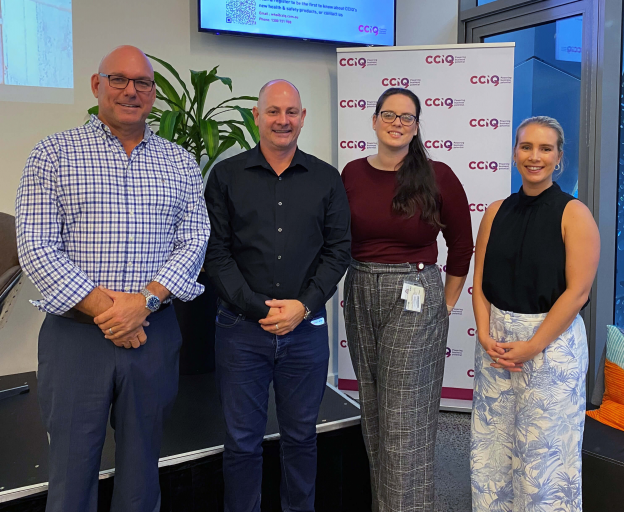Managing the worker’s compensation process to protect your staff and business
CCIQ heard from Darren Sharry, National Manager at DWF Risk, Marissa Coward, Special Counsel at DWF Australia and Elizabeth Kelly, WHS Consultant at DWF Risk at a recent CCIQ and Brisbane Business Hub masterclass on managing the worker’s compensation process to protect your staff and business. Workplace health and safety extends beyond traditional workplaces. Since we all have the flexibility to work remotely, workplace health and safety now, increasingly, not only covers employees in retail spaces, manufacturing facilities, construction sites or other traditional places of work but also people working from home.
Reducing premiums
Employees working in high-risk areas such as construction sites, forklift operations or scaffolding areas are required to be insured by paying high premiums whereas employees working in low-risk areas such as an office space can be insured at a low premium cost. Marissa mentions, if 60% of staff are required to work from an office space and only 40% of staff is on the ground, insurance premiums can be adjusted accordingly and calculated at a 60 – 40% ratio.
Preventing workplace incidents
-
Employers need to conduct a WHS risk assessment of the business, operations and workplace. Assess and prevent before an incident takes place.
-
Put WHS documentation – policies, procedures and work instructions in place to prevent any incidents and injuries.
-
Prepare the Work Health Safety documentation and ensure that these documents are practically implemented in the workplace.
-
Train and induct your workers on all the above documentation and make sure you are recording these trainings and inductions.
-
Ensure that your workers have the required PPE and other relevant equipment to safely carry out their duties.
-
Ensure your workers have the required skills, qualifications, and experience to safely carry out their duties.
-
Ensure you are regularly monitoring and reviewing all of the above.
Elizabeth Kelly says these measures in place will only prove to be effective if they are regularly monitored and upgraded as needed. Re-visiting WHS documentation, personally speaking to your employees and physically visiting your work premises (high risk and low risk) will provide you with an insight and let you know of current state at the workplace which is a practical and highly beneficial way to prevent a workplace incident.
What to do if a workplace injury occurs
-
If an incident occurs at a workplace, Elizabeth mentions that an employer should contact the worker as soon as possible and ensure the details of the injury/incident are recorded. From an employees’ perspective as well, immediately inform your workplace about the injury if you’d like all your immediate medical expenses covered.
-
Secondly, advise WorkCover Queensland about the injury within eight days of becoming aware of it, even if the worker doesn’t make a claim.
-
Under certain circumstances, you may need to notify Workplace Health and Safety Queensland (WHSQ) of a work-related injury or illness.
-
Work with the worker to start planning their return to the workplace as soon as you can.
Key facts
-
If an employee is out of work for less than 20 days, there’s a 70% chance they will return to work.
-
If an employee is out of work for 70 days, there’s only a 35% chance they will return to work.
Therefore, be proactive and work with your employees to plan their return.

Worker’s compensation claim process
Both a worker or employer can file an application. Once the claim is lodged, the first step is ‘Information gathering’ where the WorkCover team will contact the employee, employer, medical providers, witnesses etc.
Darren mentions WorkCover aims to make a decision within 20 business days. If the claim is accepted, payments and support are put in place. Focus shifts on getting back to work, DPI assessment, offers of lump sum compensation are made.
Getting back to work and rehabilitation
-
Rehabilitation prevents emotional and financial stress
-
Employee and employer can come to an agreement and design a suitable duties plan for the employee to identify tasks that can be performed whilst respecting their skills and experience in the field. This will not only help an employee keep their routine and regain confidence but also will maintain their income and help them develop confidence. Additionally, this reduces the employer’s premium cost, their workforce is maintained, and they don’t need to hire and train new staff.
Alternatives to Suitable Duties Program
Not all employers can offer alternative tasks to an employee, sometimes for practical or safety reasons, Recover at Work (‘Host Employment’) through WorkCover Queensland can be considered as an option, read more here.
Top three takeaways:
-
Improve return to work strategies such as suitable duties plans, maintain a safe work environment and work with Workplace Health and Safety Queensland to develop workplace health and safety initiatives.
-
Appoint a Return to Work Coordinator to ensure a suitably competent return to work process for any injured workers.
-
Getting back to work is important for employer and employee; a suitable duties plan using skills and experience to identify alternative tasks can help employee maintain their income and regain confidence.
For more information on Worker’s Compensation, please visit here or speak to our HR consultant on 1300 365 855.







